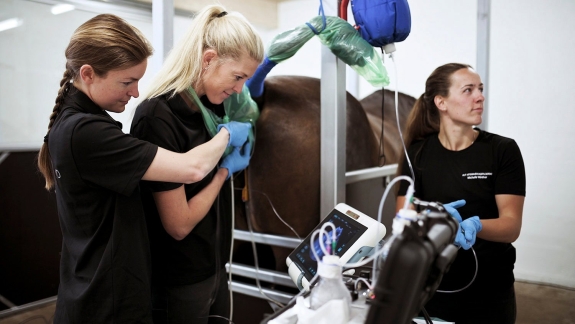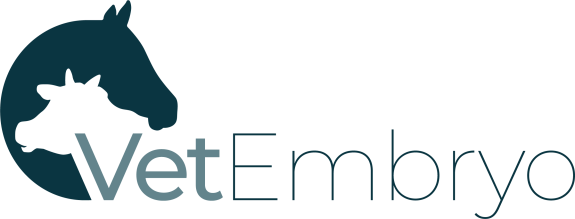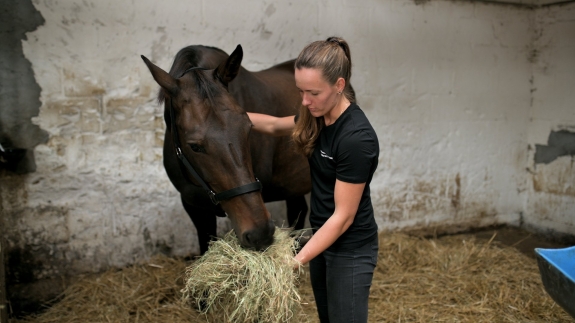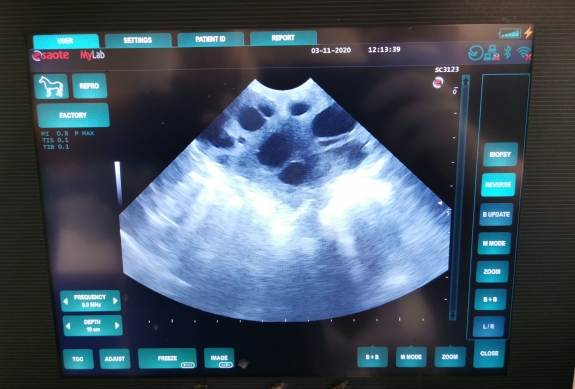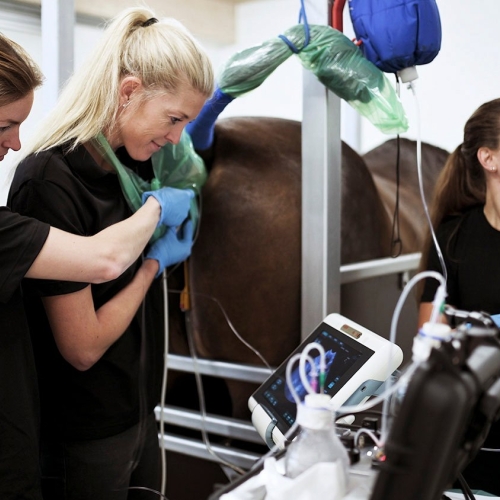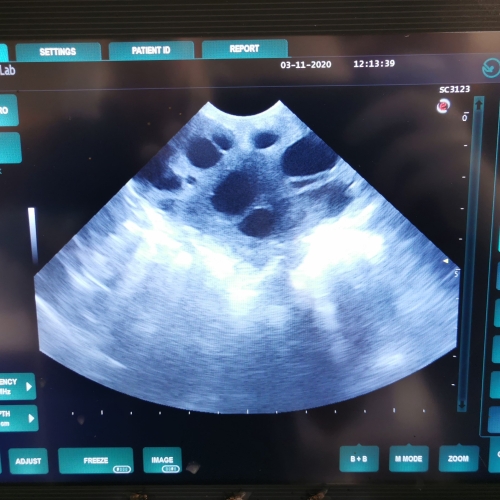Oocyte pick-up (OPU) and subsequent fertilization (ICSI) in the laboratory are suitable for mares that cannot have foals themselves. This also applies to mares that are competing in sport, mares with different reproductive difficulties, and older mares which can no longer carry a pregnancy to term. It may also just be done due to the owner’s desire for the mare to have more than one offspring a year. Most of the embryos are vitrified (frozen), so you do not need to transfer the embryo to a recipient until it fits into your plan, or the right recipient mare is ready. The choice is yours!
Collection of oocytes is also called ovum pick-up, abbreviated as OPU. At VetEmbryo, we do OPU every Monday and Tuesday in Hellevad, Southern Jutland, Denmark. Book in advance as we have a limitation on the number of mares we can do per day. The registration for an OPU session is binding.
When is my mare ready for OPU?
We recommend that before you arrive your own veterinarian scans your mare to make sure there are enough follicles. There must be a minimum of 10-15 follicles in total, of 0.5-2.5 cm in size, before your mare is suitable for OPU. Some mares never produce 10-15 follicles, and with them, we may have to do OPU with fewer follicles.
The image to the right shows a cross-section of an ovary. This is an example of an ovary that is suitable for OPU with many small follicles of 0.5-2 cm in size.
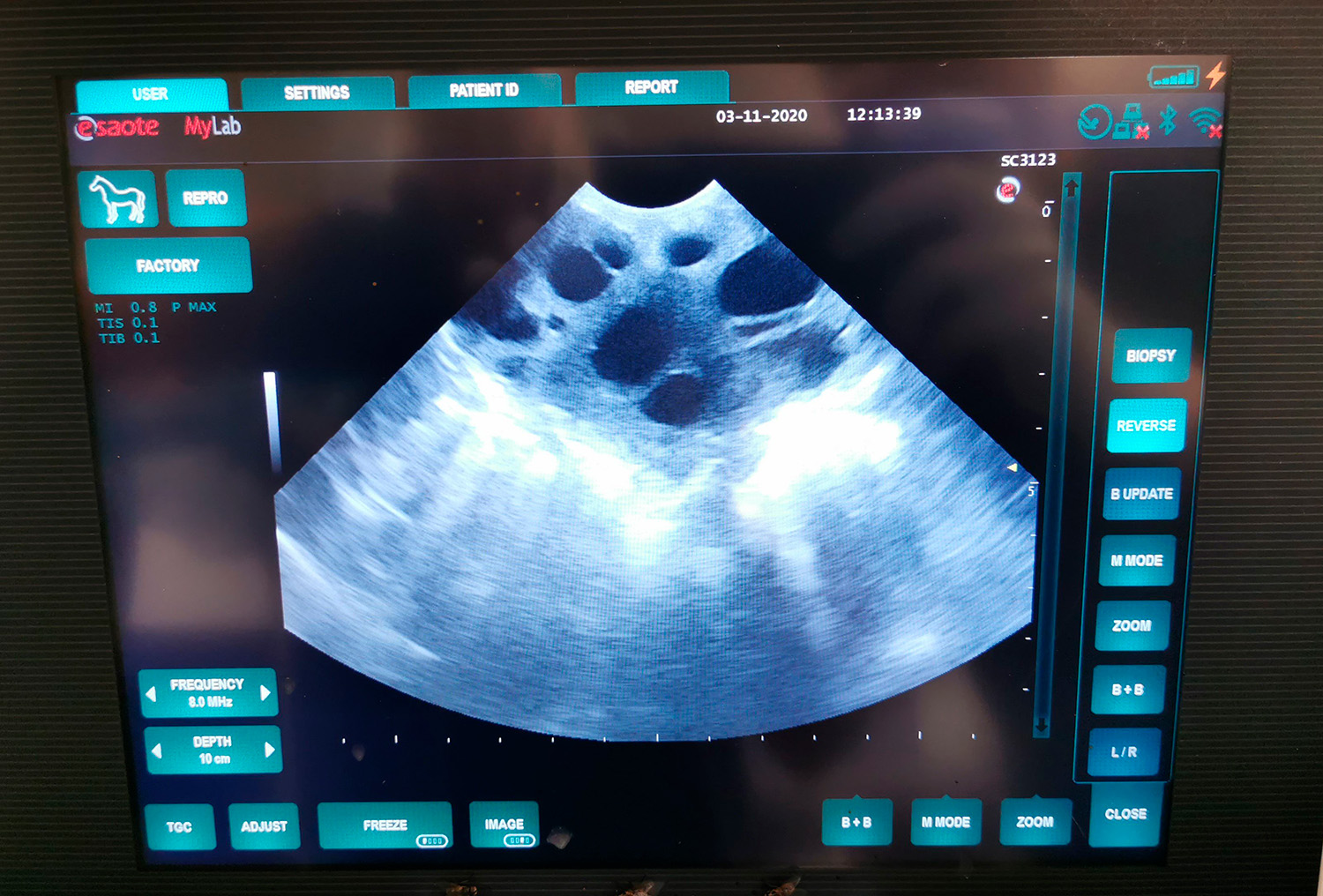
Description of the OPU procedure
The procedure itself takes place on a standing horse in a stock. We place great emphasis on everything taking place in a quiet environment without outside interference, to create the best result for the horse and for you as the owner.
The horse is anesthetized in the box and led into the stock when it relaxes. The amount of sedative depends on the size and temperament of the horse. Most often, the horse is supplemented once or twice during the procedure. In some cases, especially with young horses, the necessary state of anesthesia can still not be created. In those cases, we always choose to stop the procedure and put the mare back in her box. We give high priority to the mare being unaffected during the procedure and that she feels comfortable shortly after without unnecessary inconvenience.
OPU is done by inserting a needle through the vaginal wall into the mare’s ovary. The needle and probe from the scanner are protected in a ‘guide’, which is a kind of metal arm. The needle consists of two cavities. In one cavity, the fluid flows into the follicle, while in the other the aspirated fluid flows back, and by means of tubes it is collected in a bottle. All this is controlled by an automated pump system.
The ovary is fixed through the rectum with the guide placed in the vagina. The scanner probe helps to have full control of the location on the ovary, and makes it possible to aspirate even the smallest follicles. The follicles are emptied and filled with a special media. The procedure is repeated 8-10 times for each follicle. The oocyte is firmly anchored to cells in the follicle wall. To loosen the oocyte, the inside of the follicle wall is scraped with a needle. The smaller follicles are preferred, as it is easier to scrape the entire follicle wall, and the chance of getting the oocyte out is thus higher. Most mares will stand with many small follicles throughout the winter. The more oocytes, the greater the chance of one or more embryo forthcoming.
When all available follicles are emptied, the liquid is filtered. The oocytes are found in this filtrate. They are so small that they can only be seen under a microscope. Once the filtrate has been searched, the oocytes are washed and packed. In the laboratory, the oocytes mature for approximately 30 hours, after which they are ready for the actual fertilization, also called ICSI (intracytoplasmic sperm injection). Depending on the number of follicles, the OPU procedure takes from 30-45 minutes.
Following the OPU procedure
When we have finished the OPU, the mare is brought back into her box to wake up from the anesthesia. She is given analgesic, antibiotics, and bowel relaxants in connection with the procedure. Most mares are ready to go home after 2-3 hours. Your mare is ready to be transported when the anesthetic is completely out of her body, and she shows signs of appetite.
Depending on the length of the transport, you are always welcome to bring your mare the day before or wait for the pick-up until the following day.
Practicalities on the OPU day
Your mare must arrive no later than the day of the OPU. If you live far away, we recommend that the mare is allowed to stay overnight until the following day. We do this to ensure that the mare has time to recover after the OPU. If the mare is usually stressed and restless during transport, this is especially important.
You can also have your mare housed at VetEmbryo for a shorter or longer period. We scan the mares once a week and plan the OPU. How often we can do the OPU depends on the individual mare, but on average approximately every three weeks. We prioritize our OPU mares being outside most of the day. We feed the mares with hay/silage and concentrate with the right composition of vitamins and minerals. We have large paddocks. Most of the mares are grouped together in pairs because we believe it provides the best well-being.
Always arrive in time for your appointment. It is an advantage if your mare has time to settle in our OPU stable before she is sedated. Stress immediately before anesthesia usually results in the need to give the mare a larger amount of anesthesia to achieve the desired effect. We prioritie a quiet and relaxed atmosphere, as it provides the best possible condition both for the mare and for us.
The exact time for the OPU is variable since the number of follicles in each mare can differ widely. This means an OPU session can last from 30 minutes to, in rare cases, 1.5 hour.
We do not have clients with us during the session. You are welcome to watch the procedure through the glass door, or wait in the reception, if the mare is to return afterwards. However, you must be aware that the mare must have a minimum of 2-3 hours after OPU before you can take her home. The mare is only sent home when she is fully awake and shows signs of appetite.
Discharge
When you pick up your horse, you will receive discharge instructions. They describe how many oocytes we have found and what you should take into account when the mare comes home. Some mares may be in slight pain, depressed, or have a mild fever in the following days. We recommend taking the mare’s temperature for the first few days. If your mare is unaffected, light work can be initiated after approximately three days. You must be aware that there will be a withdrawal time in relation to competition. We proceed working with the oocytes in the laboratory, and will contact you after approximately 10 days, with the results.
Which mares are suitable for OPU?
The young mares
In principle, all mares can have OPU done. However, we have experienced that some of the very young mares, which have not yet had a foal, can feel discomfort during and in the days after OPU. This is due to the ovaries that are held by connective tissue bands or ligaments. These ligaments are tight in the young mares, as they have not yet been stretched out by a fetus. As a consequence, it can be difficult to move the ovaries around.
When we do the OPU, we need to be able to move the ovaries around in order to make the scanner probe and the ovary lie very close to each other. It often becomes necessary to pull the ligaments, and in some mares this creates discomfort. Even though the mares are in a deeper, standing anesthesia, they will usually still react when the ovaries are manipulated around. If the mare feels uncomfortable, despite a fair amount of anesthesia, then we stop the session and the mare is returned to the box. The health of the mare is extremely important to us.
However, there are many younger mares that can easily have OPU done, even if they have not had a foal before. We cannot tell before we have tried. However, we would like to inform in advance that with some mares it turns out not to be possible, and we therefore reserve the right to interrupt the session if the mare feels discomfort or is restless during the OPU.
The older mares
OPU and ICSI are ideal for older mares. A large proportion of the horses we work with come either because they are too old to carry a foal themselves, or because there have been some difficulties in relation with foaling. In older mares that have had many foals, the uterus gradually becomes worn. The result is often that the mares abort early in pregnancy, stand with a large amount of fluid before and after insemination, or have a very complicated pregnancy and show signs of pain and discomfort during the last months. When we do OPU, we go directly into the ovary. It does not matter whether the fallopian tubes are blocked or whether there is fluid in the uterus. We are not in touch with those areas.
Research shows that the older mares, all the way up to the age of 23, have an oocyte quality comparable to the younger mares. The difference is just that they have less follicles. This also means that sometimes we have to compromise on our desire for a minimum of 10 follicles before we do OPU on the old mares.
Risks and responsibilities
Oocyte pick-up
In general, the risks associated with OPU are extremely low but, as with any other procedure, complications can occur. The potential risks include rectal tears, bleeding into the abdomen, infection/abscesses in the ovaries, or peritonitis. These complications are extremely rare but, in the worst case, life threatening. There is also a potential risk that the sedation can result in mild colic for some mares. Furthermore, in rare cases (less than 2% of the mares) – and especially among the young maiden mares – the mares may experience slight discomfort the first 1-2 days after an OPU session. If any complications arise following the OPU session, we hereby inform you that the company does not have insurance that covers the value of the mare or the eventual loss of value. OPU is performed at the owner’s own responsibility. Therefore we advise you to consider insurance for your mare before the session.
Storage of embryos and semen
Storage of embryos in our laboratory is performed at the owner’s own responsibility. The embryos are stored in containers with liquid nitrogen in a secured room with an alarm system connected, but VetEmbryo is not liable for any loss, damage, or unforeseen incidents such as fire or theft. VetEmbryo does not insure the stored embryos. It is the owner’s responsibility to purchase insurance if desired.
DNA mismatch
The client accepts that when using advanced reproductive techniques, there is a very small risk that errors may occur that could lead to an incorrect DNA parentage of the ICSI foal. If the pedigree in connection with a genetic analysis of the embryo or foal is incorrect and VetEmbryo can be held responsible for this, any liability in any case will be limited in amount to the costs of the OPU, ICSI, and freezing of the embryo as invoiced by VetEmbryo.
Pregnancy test
The client accepts that there is an approximately 15% risk of pregnancy loss after the first confirmation of pregnancy on day 14. In addition, there is a small risk (~2%) of twin or triplet pregnancies arising from the transfer of one ICSI embryo. One must therefore be extra careful to have the recipient mare checked for a fetus with heartbeat around day 30. VetEmbryo cannot be held liable for any pregnancy loss due to twins/triplets.
Success rate
In average there is a 65% chance of getting one or more embryos from one OPU session. Many factors such as the number of follicles, the number of oocytes recovered, the age and health-status of the mare, the quality of the oocytes and semen have an impact on the result. After transfer of the embryo to a recipient mare, there is a 70% chance of the embryo establishing a pregnancy. This mean your chance of getting a live foal after one OPU session is 45%.
We take you
through the process
In this video, we take you through the whole process;
from oocyte pick up, over ICSI to transfer of the embryo.
